DALL·E 3 Prompts: Exploring The Possibilities of DALL·E 3
Once upon a time, the idea of robots embracing creativity seemed like a distant dream. Many believed that robots could solve complex math problems, but asking them to write a poem or paint a masterpiece was beyond their capabilities. However, the times have certainly changed. Today, we see bots that effortlessly generate song lyrics, tell jokes, and even produce Picasso-style paintings in mere seconds. It’s as fascinating as it is intimidating, isn’t it?
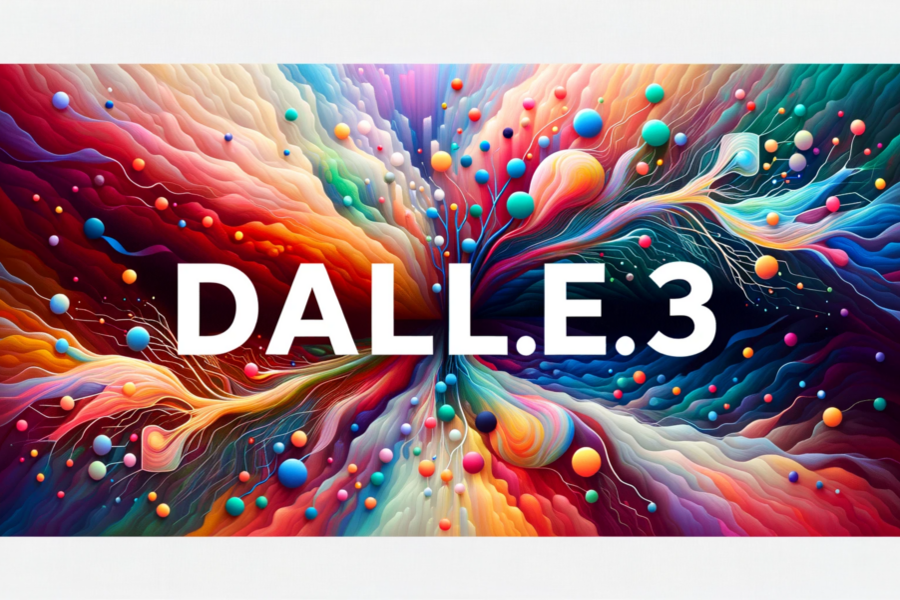
Another key point to remember is that OpenAI, the makers of DALL.E and ChatGPT stands at the forefront of this remarkable AI progress. And now, they’ve added another feather to their cap with the introduction of DALL·E 3. What sets this apart is that, for the first time, you can give it a test drive on ChatGPT. Whereas the API and Labs versions are set to arrive this fall.
Curious about exploring this unique combination of ChatGPT and DALL·E 3 but don’t know where to start? Then you’ve come to the right place. In this blog, we’ll provide you with a brief overview of DALL·E 3. We’ll also quickly go over some ideas and strategies for coming up with the best DALL·E 3 prompts to make the most of this upgrade.
So, shall we begin?
DALL·E 3 – an Introduction
About a month ago, OpenAI posted the below video giving a glimpse of what’s in store for DALL.E users and the social media went crazy. The anticipation has been high since then.
What made the announcement even more exciting was that OpenAI revealed that ChatGPT Plus and Enterprise users will be the first ones to get a taste of DALL·E 3 (unless you have explored it on Bing Chat, that is). And the beta version finally went live on October 19th.
DALL·E 3 is now available to all ChatGPT Plus & Enterprise users, letting you create unique images through conversation.
— OpenAI (@OpenAI) October 19, 2023
Describe your vision, let ChatGPT generate multiple variants, and then request edits — all in real-time. https://t.co/kV3O1VGFCq pic.twitter.com/egLHgnBFpV
So, how do you access DALL·E 3?
When you start a new chat, you get to switch between modes – like using plugins or the web browsing mode or DALL·E 3 beta.
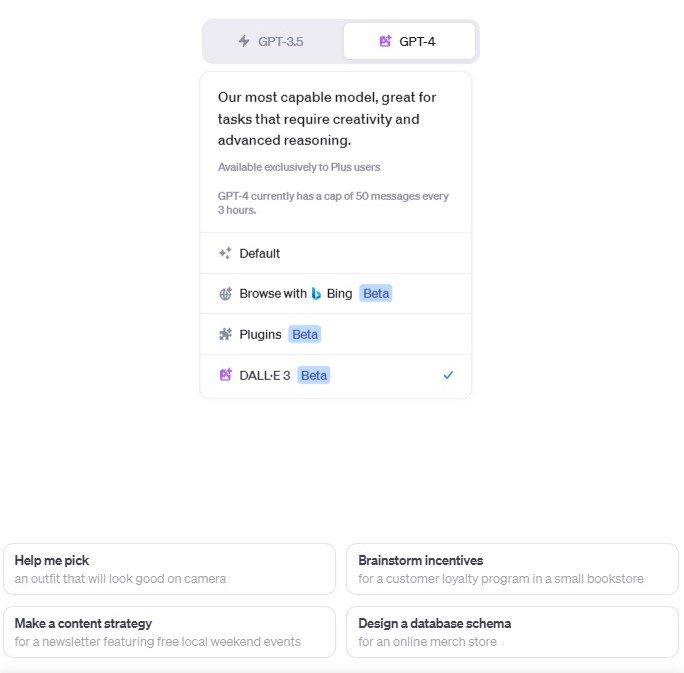
As with the other GPT-4 applications, you can send up to 50 messages in a 3-hour interval. This means that with a ChatGPT Plus or Enterprise subscription, you can generate hundreds of images on DALL·E 3 per day. Furthermore, if you have used DALL·E 3 on Bing Chat you might notice that the ChatGPT version allows you to have a little more control over your art.
Having tackled the brass tacks, let’s talk about some of the new features introduced.
What to Expect From DALL·E 3?
To show the improvements in results with DALL·E 3, OpenAI added the below example. For the same prompt, the first image was generated on DALL·E 2 and the second one on DALL·E 3.
Prompt: “An expressive oil painting of a basketball player dunking, depicted as an explosion of a nebula.”
Image 1: Generated on DALL·E 2
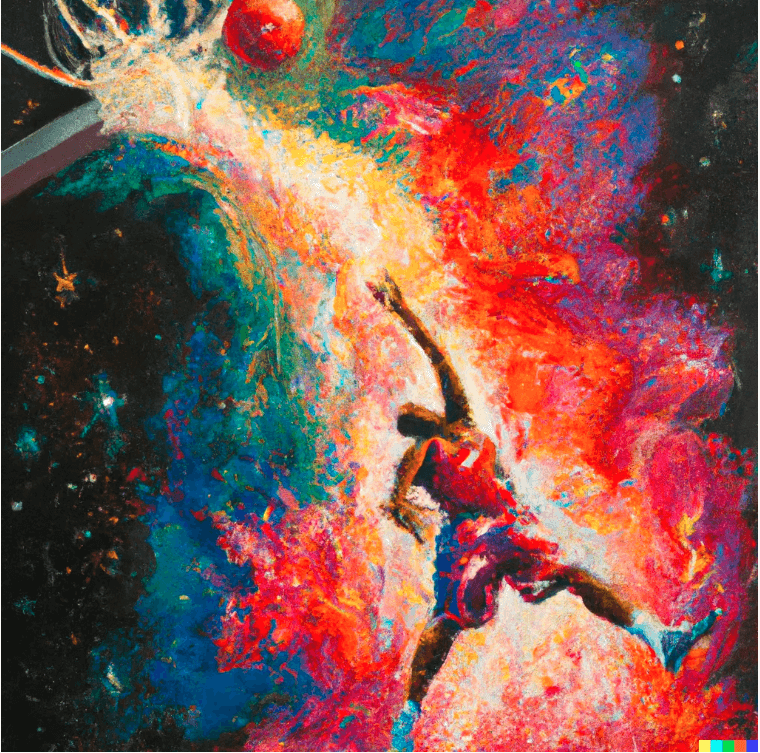
Image 2: Generated on DALL·E 3
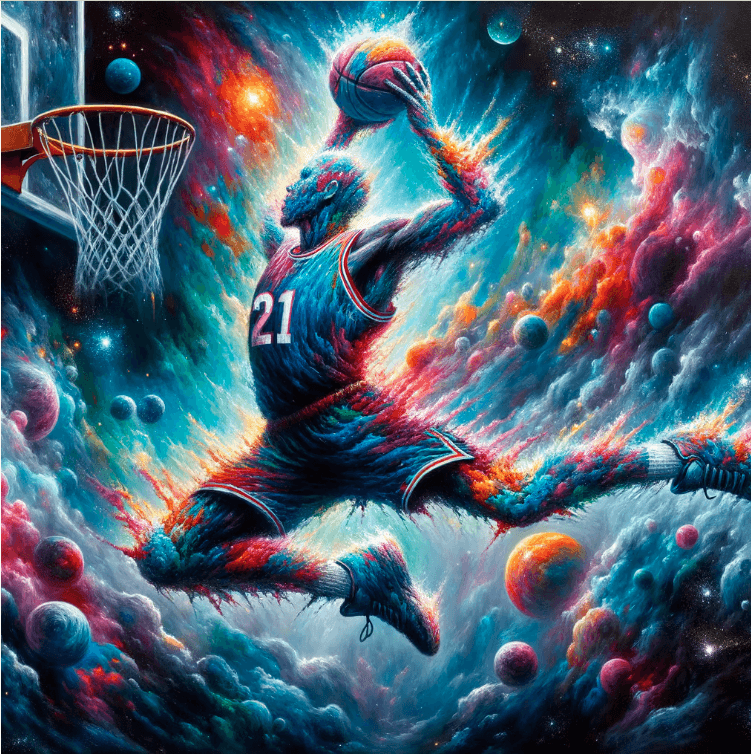
Now let’s take a closer look at all the finer improvements introduced in DALL·E 3.
(Note: We used ChatGPT for prompt ideas and DALL·E 3 for image generation)
Captures intricate details with better accuracy
Descriptive prompts yield better results but one limitation with several AI art generators is that when you have multiple details in your prompt, not all details are adhered to. OpenAI has done a great job in tackling this limitation. DALL·E 3 renders intricate details with better accuracy than the previous models.
Take a look at the variations that DALL·E 3 generated for the below prompt.
Prompt: “Design a photorealistic image of a serene Japanese garden with a red torii gate, a koi pond, meticulously raked gravel, and blossoming cherry trees.”
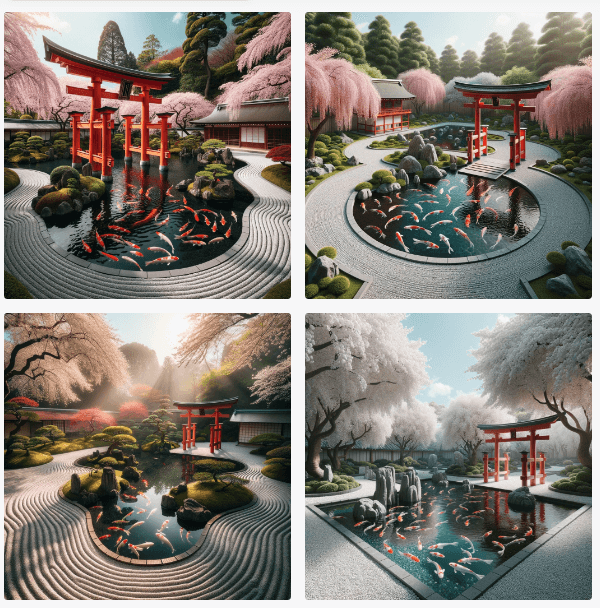
From the gravel to the Koi pond and the red torii gate, DALL·E 3 managed to render almost all the details in the prompt accurately in most images.
DALL·E 3 tweaks your prompts for better variations
We used the below simple prompt to quickly test the interface and the ease of generating images on DALL·E 3.
Prompt: “Imagine a simple living room, but render it in a distinctive Picasso style.”
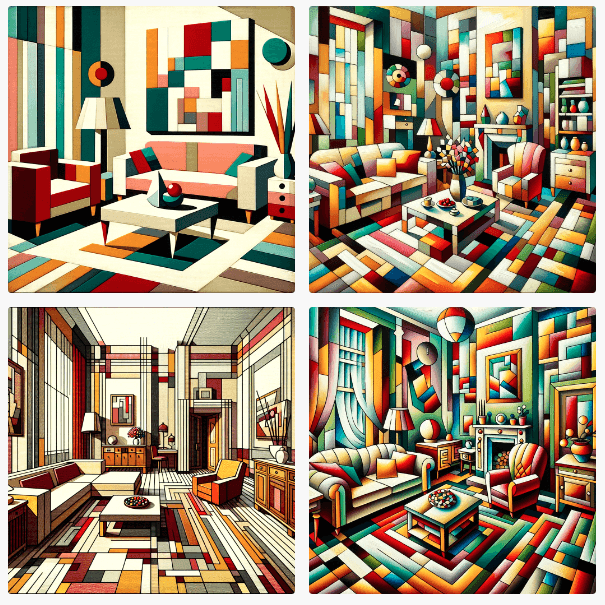
As with most AI art generators, you get 4 variations of art based on your prompt. In this case, you can click on an image to see the exact prompt that the tool processed in order to generate that particular variation.
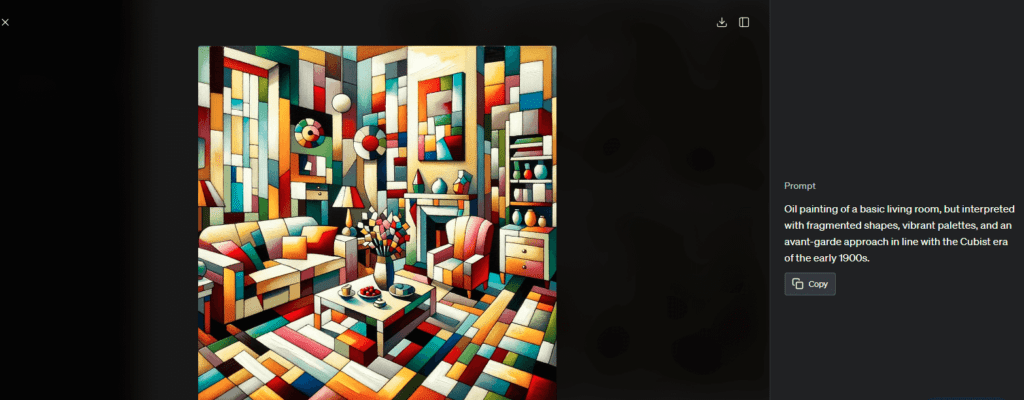
Notice that the DALL·E 3 prompts for each image are based on the original prompt we fed but more detailed. Comparing them makes it easier to understand how to tweak your DALL·E 3 prompts to get better results in the long run.
If you have used the various versions released so far on Midjourney, and noticed the difference between the opinionated V5.1 and the unopinionated V5 then you will find DALL·E 3 prompts to be much simpler to tackle.
What does all of this mean for creatives? You do not have to tire yourself about having to master prompt engineering. ChatGPT integration takes this load off of your shoulders. This is also one other reason behind the differences that some users have been discussing with respect to the performance of DALL·E 3 on Bing Chat vs that on ChatGPT.
Optimizing your results is much simpler thanks to ChatGPT
When you generate images within ChatGPT, making small changes or requesting further revisions to any image generated feels much simpler. The DALL·E 3 prompts for this can be as simple as pointing out particular aspects to change.
Here’s an example of how this can be done.
Prompt: “A cozy illustrated library scene with wooden shelves full of books, comfortable armchairs, a steaming cup of tea on a small table, and a sleeping cat on one of the chairs. The style should be warm and inviting, reminiscent of a children’s book illustration.”
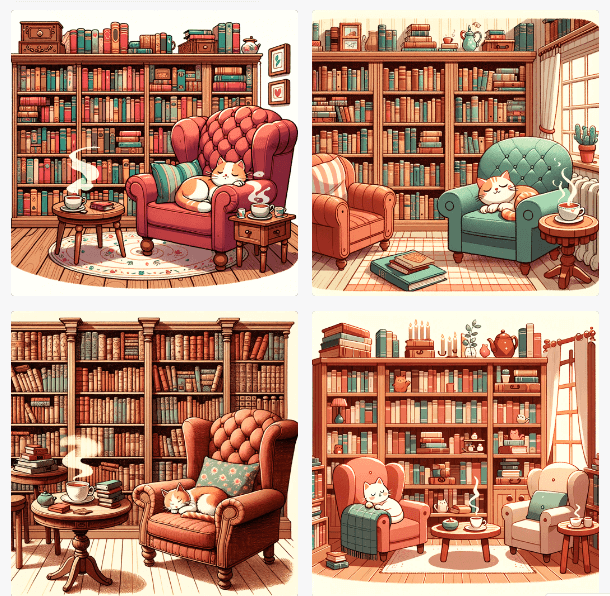
To test the ease of optimizing the results, we asked DALL·E 3 for variations of the first image with just the armchair color changing in each design. Here are the results:

As can be seen, the details were retained and the prompt was understood fairly well. However, making such variations to specific elements feels much simpler by using the seed number on Midjourney or even using Adobe Firefly to edit specific things within a design.
Refinements in terms of ethics and safety
There is still a gray area when it comes to the licensing of AI-generated art. However, to address the ethical use of AI for image generation, OpenAI has made a few announcements with DALL·E 3. They have limited the ability of DALL·E 3 to generate “violent, adult, or hateful content”.
A few more measures implemented to ensure the ethical use of AI include:
- Declining requests for images that involve any public figures by name (this is to address the use of deepfakes in spreading false information).
- A more balanced response that mitigates bias in terms of over/under-representation of specific demographics.
- Declining requests that ask the tool to imitate the style of a living artist.
- OpenAI now also has an artist opt-out option to allow creators to opt out of their works from being used to train the image generation model in the future.
DALL·E 3 is Still Not Perfect
While we cannot deny the fact that DALL·E 3 is a big step forward in the generative AI realm, it still comes with its own set of limitations. This means that even if you have the best DALL·E 3 prompts, there are still a few things that the tool might still struggle with. What are they? Let’s look at a few.
Not the most spatially aware tool yet
Descriptive DALL·E 3 prompts yield good results. That’s something we know by now. However, no matter how descriptive your DALL·E 3 prompts are, the results might miss out a little when it comes to placing the objects within the frame. In other words, the spatial awareness of DALL·E 3 is still not up to the mark.
To explain this better, here’s a prompt we used with multiple references to the placement of objects within the frame.
Prompt: “Create a vivid and realistic image of a serene living room scene. In the foreground, imagine a content cat peacefully nestled beneath a wooden table. The table is placed against a wall with windows on both sides of the table and a blank photo frame hung right above the table. The living room should be tastefully decorated with comfortable furniture, soft colors, and an atmosphere of tranquility.”
And here are the results generated. The 1st, 2nd, and 4th images captured almost every little detail mentioned in the caption, in terms of colors, ambiance, and visual style. However, the placement of the cat and the table are places where the results do not follow the prompt. This shows a visible lack of spatial awareness in DALL·E 3.
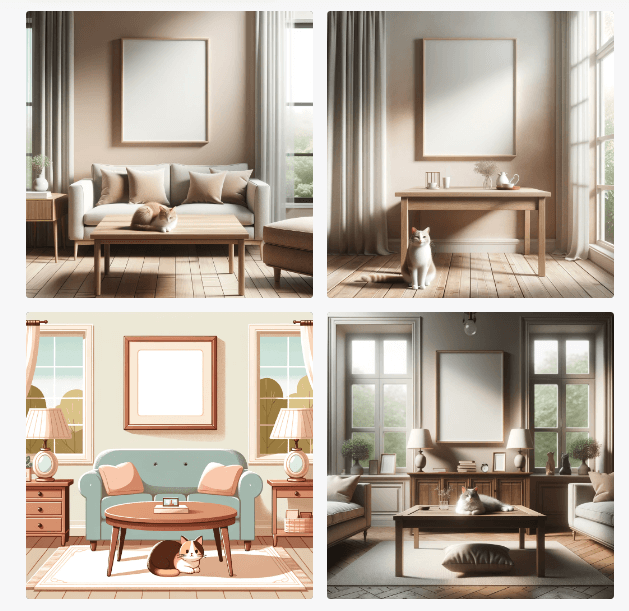
In short, if you have simple reference images to create then AI art generators like DALL·E 3 can help. However, they cannot replace human graphic designers!
Issues when handling text in images
If you have used AI art generators in the past you must have encountered the problem of random text appearing on the generated images. With each upgrade, the popular text-to-image AI tools have been addressing these limitations.
We’ve come to an era where you can now ask image generators to include specific text within the image. The same applies to DALL·E 3 as well. However, there are instances where DALL·E 3 misses the mark in terms of text rendering.
To understand this better, take a look at the below example. Notice the typo in the second image (of course, not to forget the extra set of paws!)
Prompt: “A cute cat sitting on a sidewalk, holding a placard that reads ‘For Hire.’ The cat should look friendly and approachable, with bright eyes and a fluffy tail. The setting is a sunny day in a bustling city street, with people walking by and tall buildings in the background.”
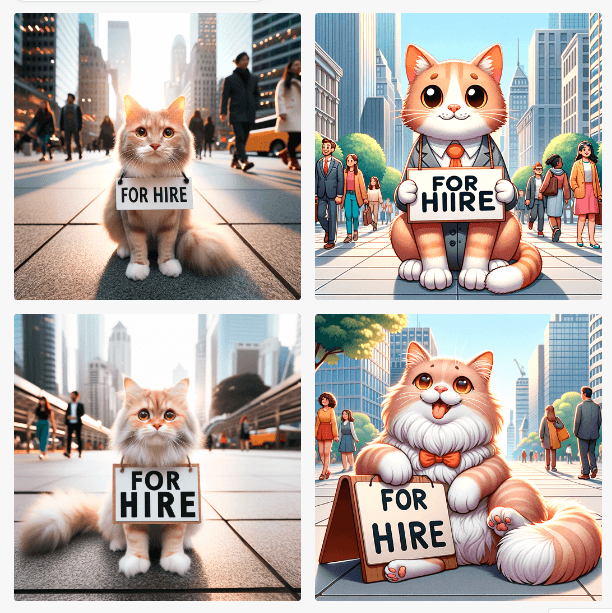
The below thread discusses how it sometimes takes several iterations to get the text correctly rendered in the image and another user on the thread also points out some minor flaws in the physical features of human subjects in the image.
Will check the exact prompt — but it admittedly took many iterations of asking, over and over again, to spell it correctly. pic.twitter.com/nhT5nM3WNH
— Ryan Delk (@delk) October 21, 2023
Now that we have seen what to expect from DALL·E 3 and what not to, let’s quickly look at what some DALL·E 3 users have to say. The many designs and use cases discussed on online forums can be a good source of inspiration if you are still wondering where to start and how to use DALL·E 3 in your creative workflow.
What Do DALL·E 3 Users Have to Say?
The increase in capabilities means an increase in use cases
The thread below explores the many ways in which you can use DALL·E 3. From branding design inspiration to room decor ideas and illustration ideas, the thread discusses the applications along with examples for each.
Just over a week ago, DALL-E 3 on ChatGPT was unleashed.
— Bryan Marley (@_bryanmarley) October 17, 2023
And the images it can create are beyond imagination.
Here are 10 amazing use cases it offers: 🧵 pic.twitter.com/eCFgUWv1KW
Generating icons using DALL·E 3
With DALL·E 3 understanding prompts better, using it to create more personalized designs like icons has been one application several users are exploring. A user points out how the results are pretty good.
Experimenting with DALL·E 3 to create a new app icon for Hotlist.
— Rik Schennink (@rikschennink) October 17, 2023
Pros: It's insanely good.
Cons: It's not great at iterating on a design direction. pic.twitter.com/o19J0JPj51
As can be seen, focusing on one design direction and generating more icons in a cohesive visual style might not be that easy after all.
We tried generating a whole icon set to tackle this and here’s what we observed.
Prompt: “Generate an icon set representing safety and hygiene features, like face masks, hand sanitizers, contactless delivery, and temperature checks, with a uniform look.”
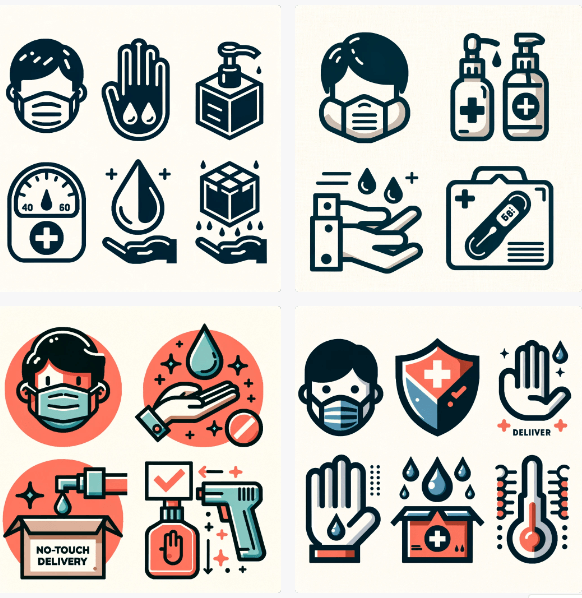
In addition to sticking to limited color palettes, there are some random elements included and some excluded in some of the icons (like the eyes missing on the face-mask icons in the first two sets). And of course, the issue of typos in the text! (the two “i”s in “deliver”). Given the current situation, you might have to import your designs to tools like Adobe Illustrator and vectorize them, to make the refinements in order to make the icons usable.
Some visual styles were better on DALL·E 2
In the below post, the designer expresses disappointment in how DALL·E 3 performs somewhat lower than DALL·E 2 when it comes to cinematic effects on images.
Dalle2 vs Dalle3
— Julie W. Design (@juliewdesign_) October 15, 2023
what a nightmare and horrendous downgrade for cinematic works?! I can't even express how awful the outputs are?? trying the prompts I used in my eBook and… wow, awful.
I guess that's why I only see cringey comic-memes…
I hope they never turn off Dalle2! pic.twitter.com/clHYKdtOZQ
As can be seen, despite the upgrades and the ease of prompting introduced, there are some tradeoffs especially when you favor particular visual styles.
Adding text in images is a major leap
The below thread presents a lot of examples that highlight how beneficial it can be with AI image generators allowing the option to add text within images. The examples also depict the efficiency with which DALL·E 3 achieves this. But yes, as we discussed earlier, it takes a few iterations to fine-tune the text and get a version without typos.
DALL•E 3 is a total game changer!
— Min Choi (@minchoi) October 6, 2023
One of its most awesome features is the ability to generate text within images.
I've been having a blast creating these schematics with simple prompts.
Stay tuned for the prompt and guide, coming soon. pic.twitter.com/BEXVOsTy8p
Experiment with aspect ratios
The images are generated in the 1:1 aspect ratio by default. However, you can also specify the desired aspect ratio in your prompt. The below post shows how adding the aspect ratio to the prompt creates designs in the intended dimensions.
Finally! DALL·E 3 inside GPT4 allows you to change the aspect ratio. Amazing GPT4 upgrade!https://t.co/uXrNfHWEEx – get 50 top prompts for free #laprompt #NFTs #nftart #AIart #imagegeneration #AIArtwork #art #artgallery #DALLE3 #GPT4 #OpenAI #bingimagecreator@LaPrompt_market pic.twitter.com/slxe1ODBFX
— LaPrompt AI (@LaPrompt_market) October 14, 2023
To explore this further, we tried using the same prompt varying just the aspect ratio specified. See the results for yourself.
Prompt: “Vintage illustration of a dragon and a unicorn playing chess in a medieval castle with an aspect ratio 2:1”

Prompt: “Vintage illustration of a dragon and a unicorn playing chess in a medieval castle with an aspect ratio 9:16”
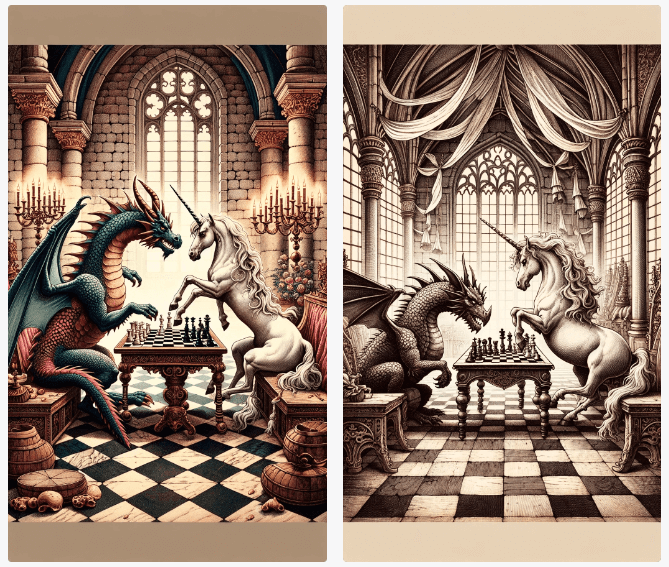
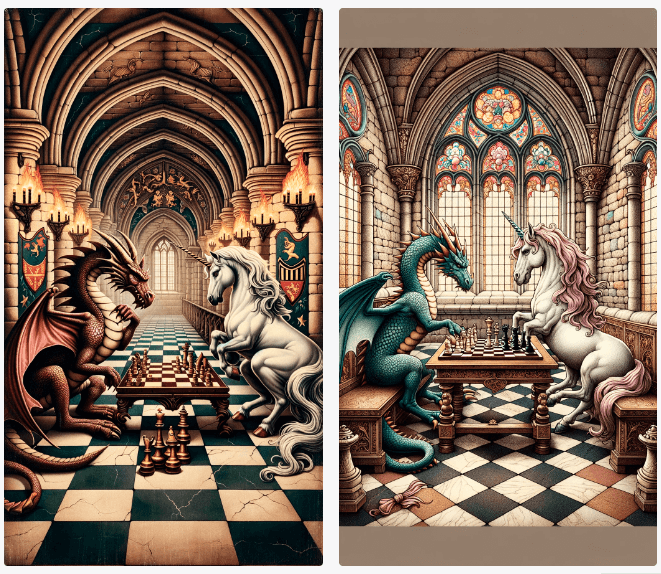
Ready to Discover the Merits of DALL·E 3?
In conclusion, DALL·E 3 truly is a game-changer in the AI-art generators realm. However, it is still lacking in some finer details when it comes to editing and touching up the generated images. Additionally, you need to get the hang of pointing out the right details to get the desired results after a few iterations. It is definitely better than DALL·E 2 in some ways but given that the tool is still in its beta, we’ll have to wait for a few more days to judge it. But one thing we can say is that coming up with the right DALL·E 3 prompts is not a tough job anymore.
The ChatGPT and DALL·E 3 combination makes things smoother, no doubt. However, these are just good tools to augment your existing design workflow and not to replace them. You would still need a reliable designer or design team that can personalize your designs and bring your ideas to life. An unlimited design subscription like KIMP with the option to get unlimited designs and unlimited revisions means that you can create as many ideas as you like on your favorite AI art generators and have your dedicated design team tweak them to resonate with your brand.
Ready to give it a shot? Register now for a free 7-day trial!
